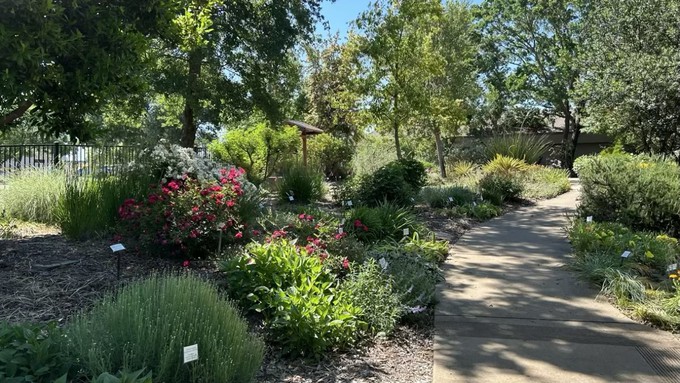
Bring questions for master gardeners during morning event

Find inspiration (and shade) at the Water Efficient Landscape of the Fair Oaks Horticulture Center. This area is open during regular park hours; the rest of the FOHC will be open as well especially for Open Garden on Saturday. Kathy Morrison
Sure, you've got gardening questions -- what gardener doesn't this time of year?
Why are the tomatoes dropping flowers? How to protect the grapes or the blueberries from critters? When's the best time to harvest lavender? How to know when compost is done? What kind of plant thrives in full, hot sun? Why didn't the peach tree produce any fruit this year?
Find answers to these and other questions when the Sacramento County master gardeners present their final Open Garden Day of spring this Saturday from 9 a.m. to noon. The informal event at the Fair Oaks Horticulture Center is free and open to the public. All areas of the FOHC will be open and staffed by master gardeners, who enjoy helping gardeners with tips and solutions to gardening dilemmas. The Horticulture Center is at 11549 Fair Oaks Blvd., south of the Fair Oaks Library.
The next event at the Horticulture Center will be Harvest Day, the master gardeners' big celebration of summer, with speakers, vendors and special presentations. Mark the calendar -- it'll be on Saturday, Aug. 5. Open Garden events will resume in September and October.
The master gardeners also will be back at the State Fair in July, daily staffing their booth in The Farm and fielding all sorts of summer gardening questions.
And a personal shoutout here to the new master gardener Class of 2023, which will celebrate its graduation this Saturday as well. The 24 newly minted MGs are a welcome addition to the busy Sacramento County group. Congrats all!
Comments
0 comments have been posted.Sacramento Digs Gardening to your inbox.
Sites We Like
Garden Checklist for week of July 21
Your garden needs you!
* Keep your vegetable garden watered, mulched and weeded. Water before 8 a.m. to reduce the chance of fungal infection and to conserve moisture.
* Feed vegetable plants bone meal, rock phosphate or other fertilizers high in phosphate to stimulate more blooms and fruiting. (But wait until daily high temperatures drop out of the 100s.)
* Don’t let tomatoes wilt or dry out completely. Give tomatoes a deep watering two to three times a week.
* Harvest vegetables promptly to encourage plants to produce more. Squash especially tends to grow rapidly in hot weather. Keep an eye on zucchini.
* Pinch back chrysanthemums for bushy plants and more flowers in September.
* Remove spent flowers from roses, daylilies and other bloomers as they finish flowering.
* Pinch off blooms from basil so the plant will grow more leaves.
* Cut back lavender after flowering to promote a second bloom.
* It's not too late to add a splash of color. Plant petunias, snapdragons, zinnias and marigolds.
* From seed, plant corn, pumpkins, radishes, winter squash and sunflowers.